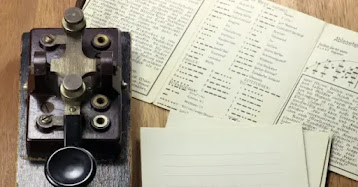The Invention of the Telegraph
For the "Each One, Teach One" presentation project, I chose to present on the telegraph, an extremely influential invention that many have likely forgotten today. Without the telegraph, many inventions that we use daily and hold great importance to were invented with the telegraph being its starter point.
In this blog post, I will be discussing the history of the telegraph and how it came to be the invention we know today. In addition, I will be mentioning the impact of the telegraph on society back then and how it has affected society today with both positives and negatives.
The History Behind the Telegraph
Before the physical telegraph product was invented, it had to have been created in the mind, and the idea of the telegraph was invented in 1798. This idea was simply a rough system that was first used throughout France. After the idea was invented, many others seeking fame claimed to have come up with the invention themselves. However, the first one to formerly claim it was Samuel Morse, who created his version of the working telegraph by 1832. With this physical version of the telegraph, he was able to claim the title of the invention of the telegraph and from there, the ways in which humans communicated only evolved.
So...how exactly did the telegraph work?
Well, the telegraph converted messages into electric impulses that could travel by wire to long-distance receivers, then converted back to readable text. This became known as "Morse Code," named, of course, after the man who not only invented the telegraph, but invented morse code which was used as the first formal way of communicating across long distances quickly.
Morse Code
Morse Code--created by none other than Samuel Morse--was used as the official 'language' of the telegraph. Instead of words being used to communicate, combinations of short and long 'tones' were used, and each sound represented a letter of the alphabet. At the time, there was no effective way to communicate through voice over far distances, so Samuel Morse came up with the idea of conversing through sounds.
Morse code was later put into use with the telegraph, which made the telegraph one of the most advanced pieces of technology at the time.
Beginning Accomplishments for the Telegraph
Samuel Morse built a huge telegraph system from Washington D.C. all the way to Baltimore, Maryland in 1843. Years later, it eventually extended to New York. In May of 1844, the first message sent on the telegraph said, "What hath God wrought?" which was an amazing accomplishment on Morse's part.
Years later, in 1864, the top telegraph company, Western Union, operated on 44,000 miles of wire and was valued at $10 million, which increased to $21 million the next year. By 1866, 100,000 miles of wire were placed around the country and Western Union reached its capital stock value of $40 million.
Flash forward 50 years, by 1910, the Mann-Elkins Act was put in place, which granted Interstate Commerce Commission regulatory oversight of the telegraph rates. By 1934, the Communications Act was created, establishing the Federal Communications Commission (FCC). It regulated radio, telegraph, and telephone communications. Due to the advancement in technology at this time, the radio and telephone diminished the impact of the telegraph.
Impact of the Telegraph
The positives:
The telegraph had a pretty existential impact on the world, but before the telegraph, there was the printing press, which was invented in 1440. With the printing press, it took days, weeks, and sometimes even months to send messages across the country. However, with the telegraph, messages could be sent over long distances within minutes. This was a huge development in technology and advancement in how to easily communicate quickly.
The telegraph improved national and international news where countries could quickly spread news and information within minutes, which also helped contribute to world peace.
In addition, the telegraph made newspapers look like 'old news.' People found it less efficient to spread information through newspapers compared to quickly spreading information along telegraph lines. With that being said, the telegraph helped encourage the idea of 'instant messaging' and started the future creation of messages through phones.
The negatives:
Some of the negatives with the telegraph was the potential to spread misinformation due to rapid transmission of the messages sent. Those that sent and received messages had to know morse code like the back of their hand, and if you know how morse code is typically used, it is very quick and without lots of experience, it would be easy to miss the message or completely misunderstand it.
To add, telegraph lines that were placed were often placed in a manor that could disrupt the surrounding environment. It could displace habitats for animals and could potentially disrupt the living conditions of people.
Conclusion
Overall, it is clear to see that the telegraph was one of those inventions that helped start the snowball of technology as we know it today. It began the idea of the telephone, which eventually evolved into the cellphone, and finally into the iPhone. Without the telegraph, technology would not be as it is today.
Join me in my next discussion where I will be highlighting my views on the topic of 'Invasion of Privacy' and how I feel about some laws/rights having access to my private life.






No comments:
Post a Comment